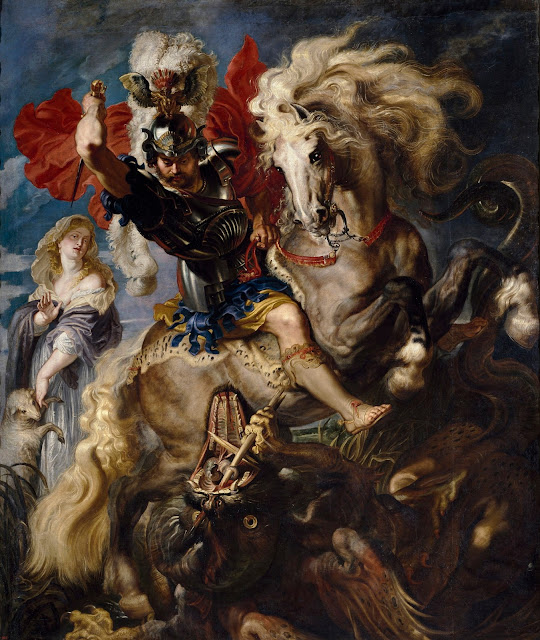 |
The Tazza Farnese
2nd century BC
Hellenistic Egypt
cameo cup of four-layered sardonyx agate
carved with allegorical figures representing Egypt's prosperity under the Ptolemies
purchased in Rome by Lorenzo de' Medici in 1471
National Archaeological Museum, Naples |
"We have a pen portrait of Piero [de' Medici]
in Filarete's treatise which brings out this atmosphere with a particular vividness. Filarete knew that Piero was smitten with arthritis and, so he tells us, he inquired from Nicodemi, the Medicean ambassador to Milan, what such a sick man could do all day, the implication being that all the noble pastimes, such as hunting or war, are barred to him.
He tells me that Piero takes great pleasure in whiling away his time by having himself carried to his studio . . . there he would look at his jewels and precious stones, of which he has a marvellous quantity of great value, some engraved in various ways, some not. He takes great pleasure and delight in looking at those and in discussing their various powers and excellencies. The next day, maybe, he inspects his vases of gold and silver and other precious material and praises their noble worth and the skill of the masters who wrought them. All in all when it is a matter of acquiring worthy or strange objects he does not look at the price . . . I am told he has such a wealth and variety of things that if he wanted to look at each of them in turn it would take him a whole month and he could then begin afresh, and they would again give him pleasure since a whole month had now passed since he saw them last.
In our present context the famous collections of the Medici are of relevance only as rivals to their patronage of art. It is too easily assumed sometimes that the two activities are one. But contemporary and past history knows of many cases in which artists complained about collectors who spent all their money on precious antiques and had nothing to spare for the living. The valuations attached to precious tableware and stones in the inventory of the Medici collection must indeed make one pause. The scribe or notary who drew up this inventory may not have been a great expert, but he must have known the correct order of magnitude. He valued the engraved gems of the Medici collection between 400 and 1,000 florins each, the Tazza Farnese [above]
even at 10,000 florins. Now the average painting by a master of the rank of Filippino Lippi, Botticelli or Pollaiuolo would range between 50 and 100 florins, and even a huge fresco cycle such as Ghirlandaio's Story of St John in Santa Maria Novella only cost about 1,000 florins."
– E.H. Gombrich, from the essay
The Early Medici as Patrons of Art, originally published in 1960, reprinted in the author's essay collection
Norm and Form (London: Phaidon Press, 1966)
Reproduced below, an array of small treasures from antiquity resembling those that consoled the afflicted Piero, each one worth roughly as much on the contemporary Renaissance market as a dozen painted panels by Botticelli.
 |
The Gonzaga Cameo
3rd century BC
Hellenistic Egypt
sardonyx cameo
Portraits of Ptolemy II and Arsinoe II
Hermitage, Saint Petersburg |
 |
The Nymph Galene
3rd century BC
Greece
aquamarine intaglio
Hermitage, Saint Petersburg |
 |
Perseus and Andromeda
1st century BC
Rome
sardonyx cameo
Hermitage, Saint Petersburg |
 |
Aphrodite and Eros
4th century BC
Greece
gold signet ring
Hermitage, Saint Petersburg |
 |
Head of Medusa
1st-2nd century AD
Rome
amethyst cameo
British Museum |
 |
Trajan and Plotina
AD 117-138
Rome
sardonyx cameo
British Museum |
 |
Augustus, Livia, young Nero
AD 50
Rome
sardonyx cameo
Hermitage, Saint Petersburg |
 |
Nero as the god Helios
1st century AD
Rome
rock crystal intaglio
Hermitage, Saint Petersburg |
 |
Triptolemus and Demeter in chariot drawn by winged serpents
1st century AD
Rome
sardonyx cameo
Hermitage, Saint Petersburg |
 |
The Blacas Cameo
AD 14-20
Rome
sardonyx cameo
Portrait of Augustus
British Museum |
 |
Hercules and Cerberus
1st century BC - 1st century AD
Rome
chalcedony cameo
Hermitage, Saint Petersburg |
 |
An Emperor as Hermes
4th century AD
Rome
amethyst intaglio
Hermitage, Saint Petersburg |
 |
Hermaphroditus with Cupids
1st century BC
Hellenistic Egypt
onyx cameo
Hermitage, Saint Petersburg |
"Elusive Lorenzo [de' Medici]
certainly was. It was not for nothing that Machiavelli, in his famous character sketch, described him as harbouring two persons – what we today would call a split personality. The contradictions of this fascinating mind have presented a perpetual challenge to his biographers, whether they resisted his charm or succumbed to it. The student of his patronage of art is confronted with the same perplexities. The very name of Lorenzo the Magnificent has come to stand for posterity as the embodiment of princely magnificence; indeed it has all but eclipsed the fame of his ancestors. It comes as a shock of surprise to realize how few works of art there are in existence which can be proved to have been commissioned by Lorenzo. . . . We have come to suspect that such moneys as he had to spend on art went into the buying of precious antique gems. Lorenzo certainly knew their value in social life; when Giovanni [de' Medici]
, the future Leo X, went to Rome as the youngest cardinal, Lorenzo wrote to him: A man of your kind should use silk and jewellery with discretion. Rather have some exquisite antiques and beautiful books."
– E.H. Gombrich, from the essay
The Early Medici as Patrons of Art, originally published in 1960, reprinted in the author's essay collection
Norm and Form (London: Phaidon Press, 1966)



























































